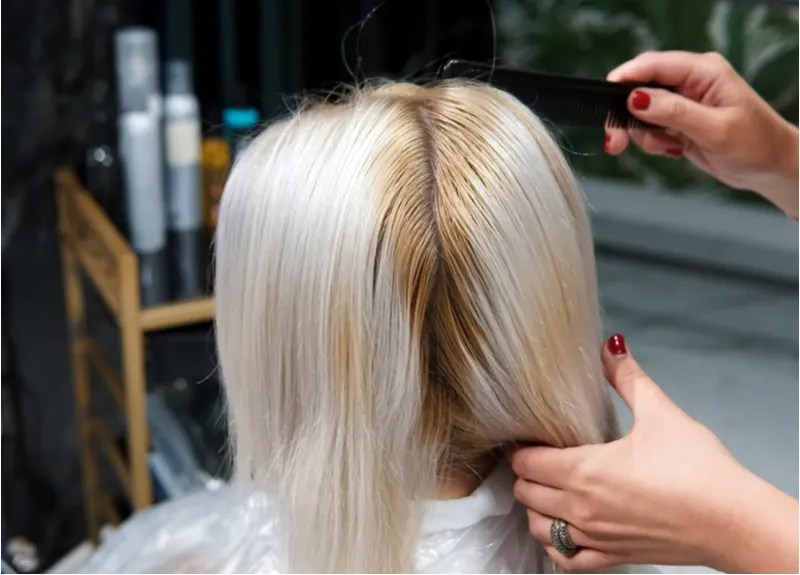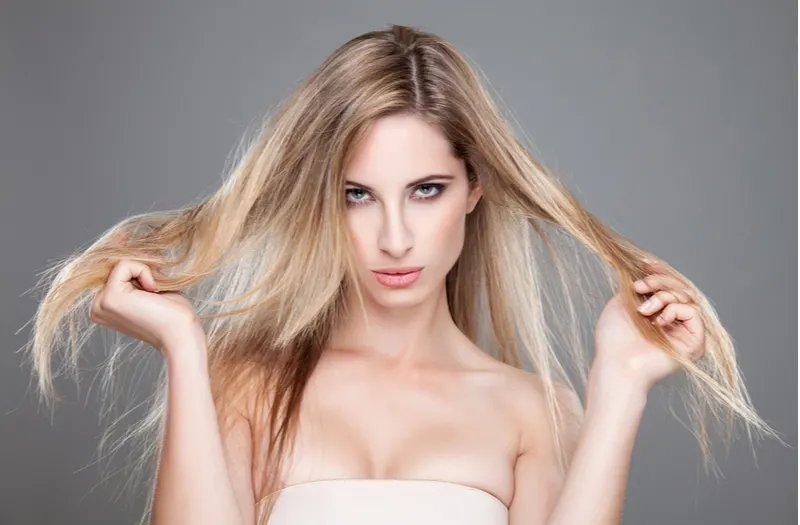Jump to:
Bleaching to lighten hair color is pretty common. On occasion, the results can look uneven. So, knowing how to fix uneven bleached hair is an excellent trick to have up your sleeve.
Fixing Uneven Bleached Hair: Quick Guide

Gleb_Leve/Shutterstock
When done right, bleaching your hair will result in a much lighter color, free of patchiness, dark spots, or other significant inconsistencies. Sometimes, things go a little sideways and don’t go to plan, and you need to take corrective action to fix unevenly bleached hair.
If that’s the case, you’ll need to follow these 6 steps:
- Allow time for your hair to recover
- Assess your hair
- Gather supplies and set up a work area
- Re-bleach your hair the right way
- Bleach your hair
- Care for your hair
In six relatively easy steps, you’re well on your way to an evenly bleached hairdo in the shade of color you want. You’ll need a little patience for the best results and the healthiest hair, but you can do it without spending hours of your life or hundreds of your hard-earned dollars at a salon.
How to Fix Uneven Bleach Hair in 6 Steps
Without further ado, here’s a detailed guide on how to fix uneven bleached hair.
1. Allow Time for Your Hair to Recover
The first and maybe the most important step for fixing unevenly bleached hair requires patience on your part. When you have a bad bleach job, it can be a little hard to wait.
But giving your scalp, roots, and hair three to four weeks to recover is essential for the process and your hair’s overall health. The waiting is hard but necessary. Otherwise, the usual downsides of bleaching can become too much for your hair to handle.
Remember that bleaching your hair can deplete its natural oils, severely drying it out and leaving it unhealthy, flat, and damaged. So, taking the time to restore your hair’s natural strength, moisture, and softness is key.
Your unevenly bleached look may even start to even out a little bit on its own or even grow on you, but that’s not always the case. Here are some things to consider as simple dos and don’ts while your hair is recovering from the initial bleaching:
Do:
- Use hair oils, leave-in conditioners, and strong conditioning treatments to feed your hair and restore its luster and moisture as much and as rapidly as possible.
- Use only warm, cool, or cold water to rinse your hair to avoid drying or scalding from hot water.
- Boost your hair and overall nutrition by ensuring you’re getting an adequate supply of minerals, omega-3 fatty acids, and minerals. Doing so has been proven to aid skin and hair health.
- Take your uneven hair in stride. It’s no big deal, and it will look great again soon! So tie a ponytail, put it up in a hat, or just let it down and go with it.
Don’t:
- Bleach your hair again right away. It needs time to recover!
- Avoid rinsing your hair with overly hot water to keep it from becoming overly dry.
- Use a hair dye to change your coloring again unless you have an emergency need to fix your uneven hair right away.
- Try to avoid blow-drying your hair as much as possible as the harshness of the high temperatures can leave it frazzled and dry.
Read Next: How Often Can You Bleach Your Hair?
2. Assess Your Hair
Take a close look at your hair in the mirror, and maybe use a couple of them to inspect it all over. You can place one mirror behind you and one in front of you to get a pretty decent all-around view.
If you have the right setup, try to use a few angled mirrors to enhance your ability to see everywhere. This way, you can easily tell if the uneven look you have going on is an all-over issue or a spot problem.
Run a comb through your hair, sectioning off areas and looking at it closely. This trick will help you to formulate a plan for correcting the unevenness without doing any unnecessary damage to your hair or skin.
If you have a few dark patches, but you’re satisfied with the rest of your hair’s overall color, it might be possible to spot treat only the dark spots, leaving the rest alone and undamaged by additional bleach. But, if you’re seeing a lot of unevenness, bleaching again all over is probably the best way to get even results for your hair color.
3. Gather Supplies and Set Up a Work Area
So, three to four weeks have passed for recovery, you’ve been feeding and conditioning your hair, and it’s healthy enough for another attempt at bleaching it. Gather your supplies, including:
- Protective gloves for your hands
- Cream to protect your face from the bleach product
- Properly prepared bleach mixture, done according to the manufacturer’s label instructions
- Comb
- Tinfoil (optional)
- Mirror, or even better, a few mirrors, and plenty of light
- A timer
- Shampoo and a pH-balancing conditioner
You’re ready to go when everything is laid out neatly, and you’ve protected any vulnerable surfaces like countertops, fixtures, and carpets from potential spills. Bleach can also damage your clothes, so you may want to cover yourself with a smock, towel, or gown.
Remember that although it works well to lighten hair, bleach is a corrosive chemical. So, take care to avoid overexposing yourself to it. Doing so can harm your health, especially if you breathe it in, ingest it, or mix it with other household chemicals. These effects can potentially be deadly.
4. Prepare to Re-bleach Your Hair
Bleaching your hair should be done carefully and precisely. So make sure you have prepared plenty of your bleaching solution so that you don’t have any risk of running out during your re-bleaching.
Now, if your assessment in Step 2 revealed that you have only isolated spots that need re-bleaching, use your comb and fingers to separate the hair you want to bleach from the hair you don’t. Gather all of the hair near the first bleaching zone, and use a sheet of aluminum foil to wrap it in a protective barrier.
Fold the foil around it, and crimp it tightly, so it stays in place around your hair. Repeat that sectioning and foil-covering process until all the hair you want to protect is safe from the bleach. You might look a little funny in the mirror, but the results will be worth it.
5. Bleach Your Hair
If you’re re-bleaching all over, you can skip all the tin foil. But you should still split your hair into sections so it’s easier to handle and treat with your bleach solution. Now, apply your protective cream to your face, getting it close to your hairline but not into your hair.
Don your gloves to keep your hands safe from the bleach. Starting at the back of your head, apply the mixture according to the directions. Generally speaking, the application process is very similar to hair dye.
Work from the middle of the shafts of hair, not from the roots. Uneven application of the bleach solution is the number one way to create an uneven look, so work precisely and methodically, from the back of your hair to the front until you’ve applied bleach to all the hair you want to lighten. Start your timer.
Let the bleach do its work for about 20 minutes before you start assessing the results. If you feel you missed a spot, take care of it now. Remove your gloves, following a safe doffing procedure that ensures you don’t get the residual bleach solution on yourself.
6. Care for Your Hair
Some people like to put on a shower cap while the bleach works, in the belief that it will help your hair hold its moisture. Doing so isn’t harmful, and it might prevent you from accidentally putting your bleach-damp hair on something susceptible to damage, but it’s not necessary.
After letting the bleach work for about 20 minutes, it’s time to care for your hair. Start by running cool to warm water in your shower or through a hand sprayer.
The cool water may be a bit uncomfortable, but the last thing your freshly-bleached hair needs is a scalding, drying blast of hot water. After a thorough rinse to remove the bleach solution, it’s time for a shampoo.
Build up a nice lather of your favorite product, and wash your hair thoroughly. Then, apply your favorite enriching conditioner. If you have a follow-up conditioner, like a leave-in product, it’s a good time to use it to restore your hair’s vitality as much and as quickly as possible.
Frequently Asked Questions

And-One/Shutterstock
Now that you know how to fix uneven bleached hair, here are some other tips you may find useful:
Can You Dye Uneven Bleached Hair?
You can dye unevenly bleached hair. But, there’s a catch. It may still end up looking uneven. Never use a dye that’s of a lighter tone than the lightest part of your hair, or it will create a pronounced uneven look.
If you opt to dye it, make sure you’re using a color that’s darker than all your hair, but keep in mind, this is the opposite effect of bleaching!
How Do You Fix Blotchy Bleach?
If your bleaching results in blotchiness, it’s pretty likely you missed spots or applied the product unevenly. Or, if you ran out and had to mix up more solution during your bleaching, you likely had varying concentrations. The solution is to let your hair recover for a few weeks and then try again.
How Do You Fix Uneven Hair?
The best way to fix uneven hair from bleaching is to wait at least three weeks and then re-bleach your hair, either as a spot treatment or all over.
Can I Re-bleach my Hair the Same Day?
Bleaching is not healthy for your hair. Using bleach to lighten your hair twice in one day is asking a lot from both it and the sensitive skin on our scalp. Even if you’re unhappy with uneven results, it’s much better to wait at least three weeks for your hair to fully recover before you try re-bleaching it.
Why Is Bleached Hair Uneven?
The most common reason for uneven bleached hair is inconsistent application. You can also end up with uneven hair if you run out of solution during the bleaching process, as the second solution you mix up might not be the exact same concentration as the first, altering its potency.
So, How Do You Fix Uneven Bleached Hair?
So now you know how to fix uneven bleached hair. There aren’t any great shortcuts, so you should also take care to bleach your hair carefully the first time, to minimize the risk of unevenness.
But, if you’re unhappy with the results, you can start feeding your hair with nutrients, letting it recover for a few weeks, and then try it again!
